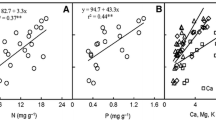Abstract
The gas exchange properties of fully expanded leaves on mature trees of Rhizophora stylosa and R. apiculata at Hinchinbrook Island, North Queensland were studied using a measurement system based on infrared gas analysers and dew point hygrometers. In some cases, CO2 and water vapour exchange were followed in diurnal ‘tracking’ experiments under natural illumination. Leaf temperature and the vapour pressure deficit inside the leaf chamber were maintained under changing conditions which simulated those experienced by other leaves in the canopy at the time. These experiments revealed that leaf temperature was a key factor controlling assimilation under natural conditions.
In other experiments, the response of gas exchange parameters to variation in CO2 partial pressure, light flux and leaf temperature under otherwise constant conditions were studied using artificial illumination. The stomata were found to be very sensitive to changes in environmental conditions, irrespective of whether these changed when simulating canopy conditions or in response to experimental manipulation. In both cases there appeared to be parallel changes in stomatal conductance and assimilation rate so that the calculated CO2 partial pressure in the intercellular spaces was maintained more or less constant. The only case when this nexus between conductance and assimilation rate was not complete occurred when CO2 partial pressures were manipulated. Maximum rates of assimilation in normal air were about 8 micromol m–2 s–1 (12.6 mg dm–2 hr–1) and occurred at a leaf temperature of about 30° C and light quantum fluxes above 700 micromol m–2 s–1.
The photosynthetic response of Rhizophora leaves to light, CO2 partial pressure and temperature were typical of the C3 photosynthetic pathway. Additional evidence for the operation of the C3 pathway in mangroves was obtained from an analysis of the isotopic discrimination against 13C by 16 species from 14 genera of North Queensland mangroves. The degree of discrimination against 13C, as represented by the δ13C value, ranged from –32.2‰ to –24.6‰. These values are typical of C3 plants and clearly more negative than the range for C4 plants. These data lead to the conclusion that, in common with most trees, mangroves photosynthesize via the C3 pathway.
Access this chapter
Tax calculation will be finalised at checkout
Purchases are for personal use only
Preview
Unable to display preview. Download preview PDF.
Similar content being viewed by others
Literature cited
Attiwill, P.M. and B.F. Clough. 1980. Studies of gas exchange in the white mangrove. Photosynthetica 14:40–47.
Hesketh, J. and D. Baker. 1967. Light and carbon assimilation by plant communities. Crop Sci. 7:285–293.
Joshi, G. V. 1976. Studies in Photosynthesis under Saline Conditions. Shivaji University Press, Kolhapur, India.
Joshi, G.V., M.D. Karekar, C.A. Gowda and L. Bhosale. 1974. Photosynthetic carbon metabolism and carboxylating enzymes in algae and mangrove under saline conditions. Photosynthetica 8:51–52.
Kimball, M. C. and I.R. Cowan. 1979. Assimilation rate and leaf conductance in seedlings of Avicennia marina. Paper presented at the annual meeting of the Australian Society of Plant Physiologists, Canberra, 1979.
Larcher, W. 1969. The effect of environmental and physiological variables on the carbon dioxide gas exchange of trees. Photosynthetica 7:167–198.
Moore, R.T., P.C. Miller, D. Albright and L.L. Tieszen. 1972. Comparative gas exchange characteristics of three mangrove species in winter. Photosynthetica 6:387–393.
Moore. R.T., P.C. Miller, J. Ehleringer and W. Lawrence, 1973. Seasonal trends in gas exchange characteristics of three mangrove species. Photosynthetica 7:387–394.
Smith. B.N. and S. Epstein. 1971. Two categories of 13C/12C ratios for higher plants. Plant Physiol. 47:380–384.
Wong, S.C., I.R. Cowan and G.D. Farquhar. 1979. Stomatal conductance correlates with photosynthetic capacity. Nature 282:425–426.
Author information
Authors and Affiliations
Editor information
Rights and permissions
Copyright information
© 1984 Dr W. Junk Publishers, The Hague
About this chapter
Cite this chapter
Andrews, T.J., Clough, B.F., Muller, G.J. (1984). Photosynthetic gas exchange properties and carbon isotope ratios of some mangroves in North Queensland. In: Teas, H.J. (eds) Physiology and management of mangroves. Tasks for vegetation science, vol 9. Springer, Dordrecht. https://doi.org/10.1007/978-94-009-6572-0_2
Download citation
DOI: https://doi.org/10.1007/978-94-009-6572-0_2
Publisher Name: Springer, Dordrecht
Print ISBN: 978-94-009-6574-4
Online ISBN: 978-94-009-6572-0
eBook Packages: Springer Book Archive




